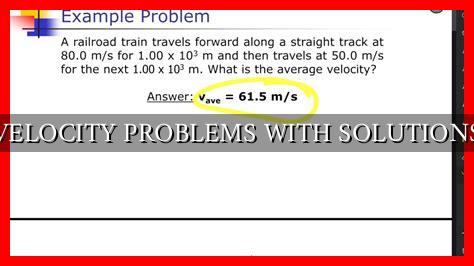-
Table of Contents
Velocity Problems with Solutions
Velocity is a fundamental concept in physics that describes the rate at which an object changes its position. Understanding velocity is crucial in various fields, including engineering, astronomy, and sports. In this article, we will explore common velocity problems and provide solutions to help you master this important concept.
Understanding Velocity
Velocity is a vector quantity that includes both speed and direction. It is often represented as v and is calculated as the rate of change of an object’s position with respect to time. The formula for velocity is:
v = Δx / Δt
Where v is velocity, Δx is the change in position, and Δt is the change in time.
. Velocity is typically measured in units such as meters per second (m/s) or kilometers per hour (km/h).
Common Velocity Problems
Velocity problems can vary in complexity, but they generally involve calculating the velocity of an object under different conditions. Some common types of velocity problems include:
- Finding the average velocity of an object over a given time interval
- Determining the instantaneous velocity of an object at a specific moment
- Calculating the velocity of an object moving in a straight line or along a curved path
Example Velocity Problem
Let’s consider an example to illustrate a typical velocity problem:
Problem: A car travels 200 kilometers in 2 hours. Calculate the average velocity of the car.
Solution: To find the average velocity, we use the formula v = Δx / Δt. In this case, Δx = 200 km and Δt = 2 hours. Plugging these values into the formula, we get:
v = 200 km / 2 hours = 100 km/h
Therefore, the average velocity of the car is 100 kilometers per hour.
Strategies for Solving Velocity Problems
When tackling velocity problems, it is essential to follow a systematic approach to ensure accuracy. Here are some strategies to help you solve velocity problems effectively:
- Identify the given information, including the object’s initial and final positions, as well as the time interval.
- Use the appropriate formula to calculate velocity based on the specific conditions of the problem.
- Pay attention to units and ensure consistency when performing calculations.
- Check your work and verify the results to ensure accuracy.
Conclusion
Velocity problems are a fundamental aspect of physics and other scientific disciplines. By understanding the concepts and formulas related to velocity, you can effectively solve a variety of problems involving the motion of objects. Remember to practice regularly and seek help when needed to improve your proficiency in solving velocity problems.
For more information on velocity and related topics, you can visit Khan Academy’s Physics resources.





